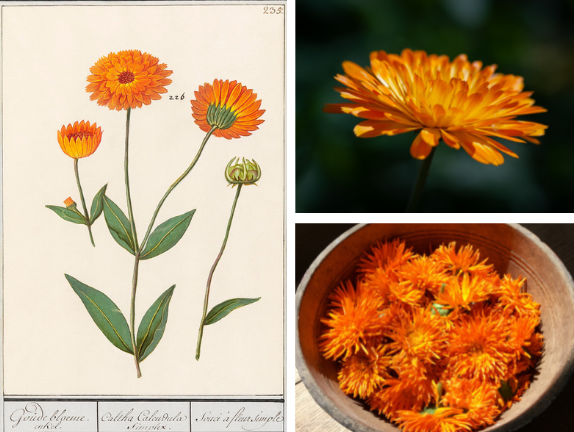Calendula officinalis
Latin Name: Calendula officinalis
Herb Class/Action: Healthy Inflammatory Response Support, Alterative, Astringent, Microbial and Fungal Balance, Emollient, Cholagogue, Diaphoretic
Parts Used: Entire flowerheads, leaves
Flavors: Bitter, slightly sweet, slightly salty, pungent
Energetics: Warming, neutral
Traditional Benefits: skin health support, gut health support, lymphatic system support, liver support, digestive support, immune support, women’s health support
A skin and gut soothing extraordinaire, Calendula offers support for a healthy inflammatory response both internally and topically. Her golden flowers encourage flow & movement within the body’s channels (including the lymph) as she calms and heals.*
Say the word Calendula (kuh·lend·yuh·luh) out loud. Notice how smoothly it rolls off the tongue? Equally as soothing as it sounds, Calendula is a gentle, soothing herb—often found in topical healing remedies and everyday skin care products (though it can be beneficial when consumed internally as well).
With medicinal uses dating back to ancient Egypt, Calendula has long-since been a staple in many an herbalist’s toolkit. This annual or perennial (depending on climate) flowering plant in the daisy family has a variety of topical and internal uses.

While the petals are useful on their own, it’s important to use the whole flower—as the base of the flower holds a lot of the plant’s medicinal power. Calendula can be applied topically as an oil, salve, or cream; consumed as an infusion, tincture, or tea; or added to broths, soups, and other foods to encourage gut health and maintain healthy lymphatic circulation.
When used externally, Calendula can help support the natural the healing process for a range of topical skin needs. The Calendula flower itself is rich in antioxidants (including lutein, beta-carotene, and rutin) and other nutrients that can help support a healthy local inflammatory response, maintain bacterial and fungal balance, and support when it comes to post-topical healing concerns such as scars.
Internally, Calendula has a variety of suggested uses. Most notably, it’s a gentle lymphatic remedy, with uses dating back to European folklore. It can help support and maintain the natural flow within our lymph nodes and beyond, and encourage healthy detoxification with its liver-supporting “alterative” properties. Calendula can also help support the respiratory system by supporting mucus balance and helping to maintain happy, easy breathing.
Last but certainly not least, Calendula is one of our greatest gut allies, known to support the digestive system with her soothing and lubricating flowers. Find her at the base of your favorite gut supporting teas, or add her to soups and broths for extra soothing power.
Calendula is a popular natural dye—producing anywhere from a greenish-tan to a bright yellow color. It can be used on fabric or even as natural food coloring.

